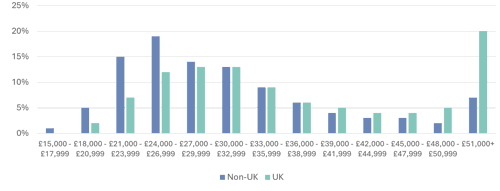
What do the latest Graduate Outcomes survey results tell us about international graduates’ employability?
September 16, 2025

This blog is a part of our UKCISA Annual conference 2025 series. It is written by:
Dr Gosia Turner, Head of Surveys at Jisc
In July, the Higher Education Statistics Agency (HESA) released the latest Graduate Outcomes survey data as accredited official statistics. This data offers the most up-to-date picture of international graduate activity from the class of 2022/23 - capturing the experiences of tens of thousands of alumni.
This rich dataset is more than just numbers - it’s a valuable resource that can inform policy, improve international student and graduate outcomes, and shape the future of higher education. As a former international student myself (University of Essex, Class of 2005), I’m particularly passionate about this part of our extensive dataset.
Run by Jisc on behalf of the sector, the Graduate Outcomes survey is the UK’s largest annual social survey. It surveys all graduates (currently just over 1 million) from UK higher education (HE) providers 15 months after they finish their course. The survey asks questions about their current activity, i.e. work, further study, travel, details of their employment (salary, duties, job title) and graduates' reflections on their current activities.
This blog looks at non-UK and non-EU graduates only. The Graduate Outcomes survey results for 2022/23 also contain outcomes for just over 19,000 EU graduates (46% response rate).
A few words about the response rate
Collecting graduate outcomes 15 months after HE course completion is neither cheap nor easy - especially for international graduates, who are often back in their home countries. With phone calls no longer part of our methodology, the response rate has decreased to 9% (12% if we include incomplete responses). This is lower than we would like and means we know the outcome for roughly 1 in 10 international students graduating from UK universities each year.
I believe that this decrease in the response rate is a key reason why the sector doesn’t make better use of this data. Unfortunately, this one number tends to overshadow our comprehensive methodology or the sheer volume of data we collect.
The untapped value of the Graduate Outcomes data
The Graduate Outcomes survey is a census, surveying only eligible graduates. We don’t scrape LinkedIn, use mailing lists, alumni networks, or work with selected providers. We cover the entire sector and have many years’ worth of data. The latest 2022/23 dataset includes responses from over 34,000 international (that is, non-UK and non-EU) graduates - more than 5,000 from India, nearly 4,500 from China, and just over 4,000 from Nigeria. This makes it the most comprehensive source of insights on international graduates from UK higher education anywhere in the world.
While the overall response rate is lower than it used to be, it’s considerably higher for doctorate research graduates, with 1,640 known outcomes - about 1 in 5 (or 20%). Response rates from Nigeria and the US exceed 15%. Although China is underrepresented among respondents (17% vs. 31% in the population), India, Pakistan, the US, and Hong Kong broadly match the graduate population, while Nigeria is slightly overrepresented (16% vs. 10%).
The Graduate Outcomes survey data dwarfs any alternative data sources in terms of volume and methodology. Tens of thousands of international graduates take the time and effort to complete the survey. This results in a high-quality and robust dataset, and we ought to make better use of this valuable resource.
Headlines from the class 2022/23
Employment: Overall, 70% of international graduates are in some form of employment, compared to 72% of UK graduates. International graduates are less likely to be in further study and more likely to be unemployed and seeking work.
Postgraduate Taught (PGT) graduates: Around 86% of international graduates completed PGT programmes. Of these, 74% are employed, compared to 77% of UK PGT graduates. Only 6% are in further study or combining study and work, compared to 13% of UK PGT graduates. Notably, 13% are unemployed and looking for work, compared to just 3% of UK PGT graduates.
Contract type: Nearly 70% of employed international graduates are on permanent contracts, with 18% on fixed-term contracts. PGR graduates are more likely to be on fixed-term contracts, while PGT graduates tend to be on permanent ones.
Job skill level: Among those employed, 64% are in highly skilled jobs and 26% in medium-skilled roles. This is a decrease from last year’s 74% in highly skilled jobs. Science graduates are more likely to be in highly skilled roles (75%) compared to non-science graduates (55%).
Comparison with UK graduates: Differences between international and UK graduates are smaller in science subjects (75% and 82% in highly skilled jobs respectively). However, among non-science graduates differences are larger, 55% of international graduates are in highly skilled jobs, compared to 72% of UK graduates.
Salaries: International graduates earn less overall than their UK counterparts. The chart below shows distribution of salaries of postgraduate taught graduates in full-time paid employment in the UK by domicile:

Perceptions of current activity: Overall, 74% of international graduates agree their current activity is meaningful - a two percentage point drop from last year. Around 64% say it fits with their future plans (a five percentage points drop) and 60% feel they are utilising what they learned during their studies (also down by four percentage points). Interestingly, UK graduates did not experience similar decline since last year.
These are just the headline findings from the 2022/23 Graduate Outcomes survey. The data can be explored over time and by country. Personally, I would like to see a breakdown by domicile, as some very preliminary analyses reveal notable differences in terms of where graduates end up after graduation and their employment status.
Where can you find more data?
I strongly encourage you to explore the data yourself - it’s a rich, underused resource that offers unparalleled insights into the experiences and outcomes of international graduates from UK higher education. All of the official statistics presented here can be obtained from the HESA website where you’ll find high-level national figures and more detailed open data.
For direct access to a range of HESA data, including the Graduate Outcomes survey, for you to visualise and analyse, Heidi Plus is the sector's essential data analytics tool. You can also purchase a tailored Graduate Outcomes survey dataset from Jisc data analytics.
Moreover, my team is always interested to hear from student career practitioners or academics who may be interested in utilising the Graduate Outcomes survey international data. You can get in touch with us via liaison@hesa.ac.uk.


